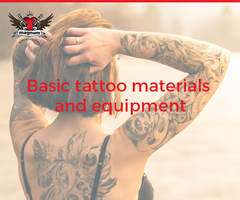Basic Tattoo Materials and Equipment 0

- Flash
The tattoo design or commonly called as “flash” is simply a sketch or a piece of line art that is used to make a tattoo. It can be black, white, or any colour. They are mounted on the walls or displayed in books in the tattoo parlour.
- Stencil
A stencil is just a copy of flash however it is crafted on a special copying paper. The stencil permits the inked outline of the design of the tattoo to be transferred to the client’s skin in order for it to be marked out by the artist.
- Ink
Special inks that are used in order to produce great tattoos are sold by tattoo supply shops. They are usually available in a different kinds of colours and are typically packaged in 4 oz plastic squeeze bottles so they are easily handed out. These inks are liquid dispersions of pigments. They are permitted by the Food and Drug Administration in the United States. The ink is composed of dyes that come from metal components. Due to this reason, allergic reaction to the type of ink used is more likely.
- Tattoo Machine
The tattoo machine is composed of a hand held needle gun attached to a power unit that makes it possible for the pressure to move the needles. The needles can come in different sizes and shapes and are packed jointly on a needle bar in various types of patterns depending on the needs of the artwork. The unit is connected to a power supply that is started by depressing a foot pedal on the floor bedside of the work station. When the pedal is depressed the tattoo needle bar moves up and down quickly. Imagine that of a sewing machine. It makes a way into the skin to inject the dye 3000 times per minute.
- Miscellaneous Supplies
For the whole tattoo procedure the artist may use supplementary supplies like skin disinfectants, petroleum jelly, bandages, razors, and biocidal cleaning supplies.
- Tattoo Removal
Sometimes people with tattoos come to a point in their lives where they decide to have their tattoo removed. Tattoo removal is now possible, thanks to advance technology, however the process is not easy, costly, and sometimes not fully successful. Not so long before, a wire brush was used to rub the skin and wipe out the first and second layers where the ink is present. In order to leach out the ink, salt solutions and acid were used to burn the skin away.
All of these methods are costly, painful, and not very effective. Even though the tattoo can be removed, the affected area may lose its capability to produce normal skin pigment and some scarring will be unavoidable. Today, lasers have been developed to remove tattoos, as it can tear down most of the ink pigment with very little scarring.
Choosing the Right Power Supply 0

A tattoo may represent a lot of things. It is not just the window to a person’s personality, it also shows how the tattoo artist interpreted their client's design. Tattoo artists who care for their clients, and who make an effort to know the needs and wants of the customers will go a long way.
A great tattoo artist gives only the best service to their clients. The make sure they have the right skills and the right equipment. This also includes the equipment used to power their machines.
Here are some of the things you need to check off your "finding-the-perfect-power-supply" list.
1. Determine the voltage required. Tattoo power supplies have a wide range of volt outputs. Some are capable of running as low as 3 and as high as 12 to 15. Some portable power supplies can run to as low as 1.5 volts and larger power supplies can run to as high as 20 volts. Obviously, the higher the voltage would mean more power will be supplied.
2. Choose the type of power supply. Analogue and digital power supplies come in both regulated and unregulated models. Your confidence level and power output reading are factors in choosing the right power supply. It is very important to look at each type available. A digital power supply gives a more accurate reading. The power is easier to check and see, even while you’re working. However, digital power supplies are more expensive. Regulated machines are pricey, but it provides you with a constant voltage even if the tattoo machine isn't running.
3. Consider the fluctuations. The amount of power required at any given time during a tattoo may change depending on the amount of pressure being applied as the tattoo needle pierces the skin. Many regulated machines will help compensate for these fluctuations. Other machines do not. Ask, research, and pick which power supply you feel most comfortable with.
4. Take into consideration your regular tattoo machine. Some tattoo power supplies are only recommended for a coil operated tattoo machine, while others can be used for a rotary machine and still others can be used for both.
5. Think of the number of machines you can hook up. Many tattoo artists prefer to set up a separate machine for lining and another for shading. It's convenient to have a power supply that allows you to plug in two machines at once and just flip a switch to change while the tattoo session is ongoing.
6. Contemplate size, weight and portability. A small tattoo power supply doesn’t automatically mean the power is suppressed. A lot of manufacturers sell compact units for those who want to save space, or for the tattoo artists who travel often.
7. Factor in price. Before deciding if the price is right, carefully take into consideration all of the factors above. You may be able to find more than one reliable machine that meets or exceeds all of your needs. If this is the case, then you start eliminating based on price.






